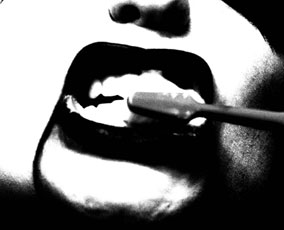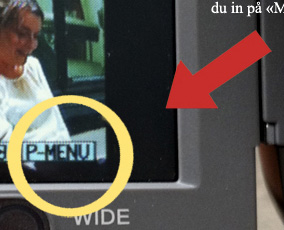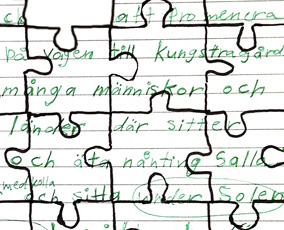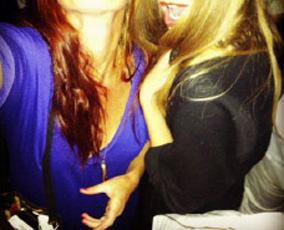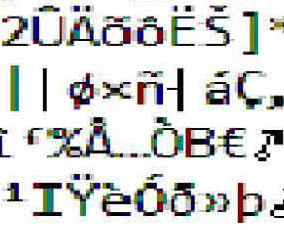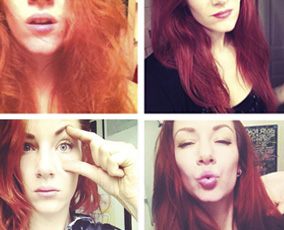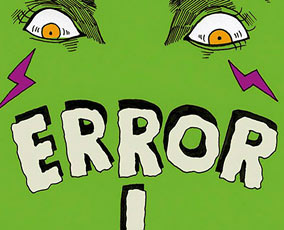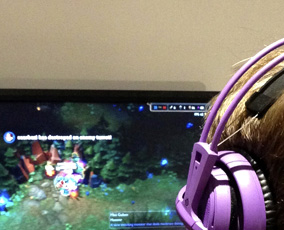Konstfack Degree Exhibition 2014 / Vårutställning 2014
Klara Bladh
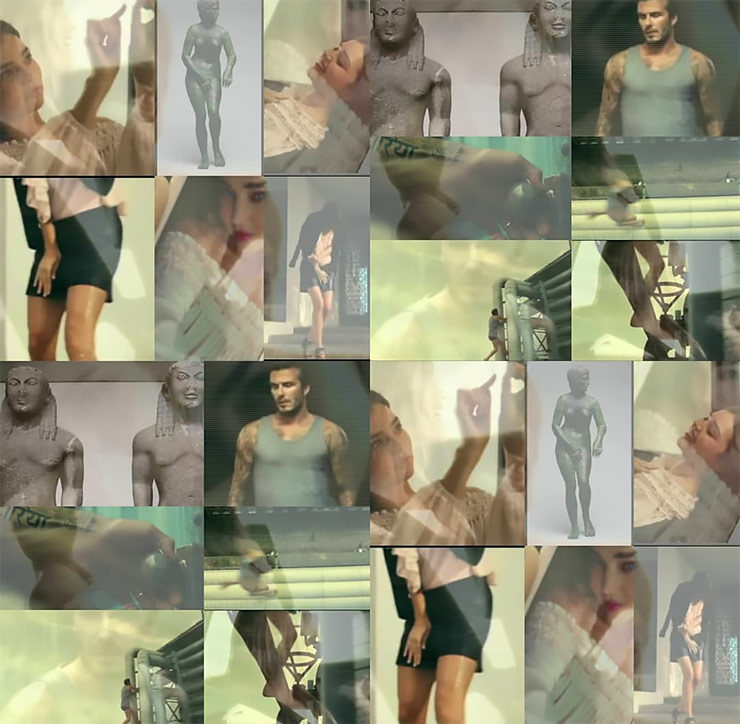
The teaching in schools aims to address the equal value of all humans as well as gender equality. But how is that depicted in images and representations used in advertising and the media? What silent message underlies the role models that young people meet in their everyday lives? The examination analyses two inspirational films that were available on the H&M website during March of 2014. The films use role models in both the female and male departments. With the aid of framing, the choice of context creates differences between the messages in each film. Miranda May Kerr is a lingerie model and David Beckham is a professional footballer. The plot of the film halts to focus on May Kerr’s body. The way May Kerr is presented prizes what she is, rather than what she does in the film. David Beckham is instead presented by what he does in the film. He is presented as a man with a good physique who accepts challenges and solves problems. Beckham’s body is in focus, but the context is different, which means that the focus on the body is secondary in the presentation. It is primarily his ability to solve problems and his ability to think and act independently that is prized.
My thinking has revolved around whether it is possible to analyse these films with the aid of an analysis grounded in feminist art history. I have studied the art historian Nanette Solomon’s theories on how iconic images have created gender with the aid of role models within art and culture throughout the ages. The Pudica gesture depicts a women who is covering her intimate parts. The motif is said to originate in the portrayal of the moment when Aphrodite rose from the sea and quickly covered her body. This scene has since been embraced and reproduced; Miranda also performs this gesture in H&M’s inspirational film.
As time goes by, ideals and technology follow along; something which I illustrate in my film, which is approximately one minute long. The female body has long been associated with guilt and shame. Miranda May Kerr and David Beckham, who are used in the adverts on H&M’s website, are the main characters in my video work. A sound clip with a jungle theme and drum sounds is suggestive of primitivism and ancient times, the fact that the body has been with us throughout the ages. Ideals, gods, beauty and role models have been with us from the dawn of man, right up to where we are now. Sections with older gender ideals indicate how culture exerts a strong influence over us with its silent message and hidden ideals. Overlapping images are interspersed with sections including Aphrodite and David Beckham. During the time of Aristotle, young athletic men were the model of the ideal man. Images with high-definition opacity are intermixed from the time of Aphrodite to Miranda May Kerr. The film’s raster is reminiscent of 1980s television. A flickering shimmer suggests the transience of time as well as my limited ability to see what it is like for the youth of today. I derive this from my own upbringing with mixtapes, VHS and portable CD players. Fan posters and girl’s magazines. The images in the paper allude to Tetris, a game based on fitting a module into another in order to create a functioning whole. There is no time for reflection and the smallest mistake creates a gap in the whole. It is in this manner. I am taking inspiration from the act of seeing as a social and cultural practice. It is all the layers of images that together create the image of a role model.
By deconstructing images within advertising, pupils can learn more about the democratic gaze. An gaze that can be directed through educational glasses and see the equal value of everyone, regardless of ethnicity, religion, gender or sexual orientation.
Undervisningen i skolan syftar att se till alla människors lika värde samt jämställdhet mellan könen. Men hur ser det ut i bilder och representationer som finns inom reklam och media? Vilket tyst budskap figurerar bakom de förebilder i media som möter ungdomar i deras vardag? Undersökningen analyserar två inspirationsfilmer som fanns tillgängliga på H&Ms hemsida under mars månad 2014. Filmerna använder sig av förebilder, på dam respektive herravdelningen. Med hjälp av bildutsnitt, val av kontext skapas skillnad i budskapet filmerna emellan. Miranda May Kerr är underklädesmodell och David Beckham är fotbollsproffs. Filmens handling avstannar för att fokusera på May Kerrs kropp. May Kerr presentation premierar det hon är tillskillnad från vad hon gör i filmen. David Beckham presenteras istället för vad han föresätter sig i filmen. Han presenteras som en man med god fysik som antar utmaningar och löser problem. Beckhams kropp är i fokus men kontexten är en annan, vilket gör att fokus på kroppen blir sekundär i presentationen. Främst premieras hans förmåga att lösa problem och förmågan att tänka samt agera självständigt.
Mina funderingar har kretsat kring huruvida det är möjligt att analysera dessa filmer med hjälp av feministisk konsthistorieanalys? Jag har studerat konsthistorikern Nanette Solomons teorier om hur ikoniska bilder har skapat genus med hjälp av förebilder genom tiderna inom konst samt kultur. Pudicagesten gestaltar en kvinna som skyler sina intima delar. Motivet ska ursprungligen skildra en ögonblicksscen då Afrodite steg upp ur havet och skyndade sig för att ta täcka sin kropp. Denna scen har sedan anammats och reproducerats, även Miranda antar denna gest i H&Ms inspirationsfilm.
Med tiden följer ideal och teknik, någonting som jag gestaltar i min cirka en minut långa film. Kvinnans kropp har under lång tid varit laddad med skuld och skam. Miranda May Kerr samt David Beckham som används i H&Ms reklamfilm på dess hemsida figurerar huvudpersoner i min rörliga video gestaltning. En ljudslinga med djungeltema samt trumljud konnoterar primitivitet och urålderlighet, det faktum att kroppen har varit med oss genom alla tider. Ideal, gudar, skönhet och förebilder har följt oss från människans första stund till där vi står idag. Inklipp av äldre genusideal, är att visa på hur kulturen har ett starkt inflytande över oss med sitt tysta budskap och dolda ideal. Överlappande bilder varvas med inklipp av bland annat Afrodite, David Beckham. Under Aristoteles tid var det atletiska unga män som stod modell för den ideala mannen. Bilder med högupplöst opacitet blandas med varandra från Afrodites tid till Miranda May Kerr. Filmens raster konnoterar 1980 talets television. Ett flimrande skimmer, konnoterar tidens förgänglighet liksom min begränsade förmåga att se hur det är för dagens ungdom. Jag härleder till min egen uppväxt med blandband, vhs och bärbar cd-spelare. Idoler på posters och veckorevyn. Bildrutorna i uppsatsen konnoterar tetris, ett spel som bygger på att en ska passa in en modul i en annan för att skapa en fungerande helhet. Det finns inte tid till eftertanke och minsta misstag skapar ett hål i helheten. Det är på det viset jag härleder till seendet som en social och kulturell praktik. Det är alla lager av bilder som tillsammans skapar bilden av en förebild.
Genom en dekonstruktion av bilder inom reklam, kan elever lära sig mer om den demokratiska blicken. En blick som kan användas genom pedagogiska glasögon och ser till allas lika värde oavsett etnicitet, religiös tillhörighet, genus eller sexuell läggning.


